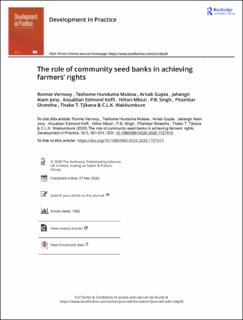The role of community seed banks in achieving farmers’ rights
| dc.contributor.author | Vernooy, Ronnie | |
| dc.contributor.author | Mulesa, Teshome Hunduma | |
| dc.contributor.author | Gupta, Arnab | |
| dc.contributor.author | Jony, Jahangir Alam | |
| dc.contributor.author | Koffi, Kouablan Edmond | |
| dc.contributor.author | Mbozi, Hilton | |
| dc.contributor.author | Singh, P.B. | |
| dc.contributor.author | Shrestha, Pitambar | |
| dc.contributor.author | Tjikana, Thabo T. | |
| dc.contributor.author | Wakkumbure, C.L.K. | |
| dc.date.accessioned | 2021-11-15T07:51:27Z | |
| dc.date.available | 2021-11-15T07:51:27Z | |
| dc.date.created | 2020-03-30T15:08:09Z | |
| dc.date.issued | 2020 | |
| dc.identifier.issn | 0961-4524 | |
| dc.identifier.uri | https://hdl.handle.net/11250/2829493 | |
| dc.description.abstract | The core objectives of the Convention on Biological Diversity and the International Treaty on Plant Genetic Resources for Food and Agriculture (ITPGRFA) are the conservation and sustainable use of plant genetic resources. The ITPGRFA links these goals explicitly to farmers’ rights. Although farmers’ rights have been debated intensely at international level, their effective implementation at national level remains a major challenge. Community seed banks are good examples of effective implementation of those rights, but have received little attention in scientific literature and policy circles. Case studies in this article from Bangladesh, Côte d’Ivoire, India and Zimbabwe illustrate how this knowledge gap can be filled. | |
| dc.language.iso | eng | |
| dc.title | The role of community seed banks in achieving farmers’ rights | |
| dc.type | Peer reviewed | |
| dc.type | Journal article | |
| dc.description.version | publishedVersion | |
| dc.source.journal | Development in Practice | |
| dc.identifier.doi | 10.1080/09614524.2020.1727415 | |
| dc.identifier.cristin | 1804287 | |
| cristin.ispublished | true | |
| cristin.fulltext | original | |
| cristin.qualitycode | 1 |
